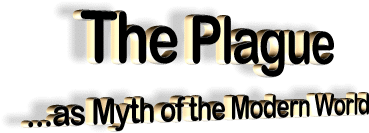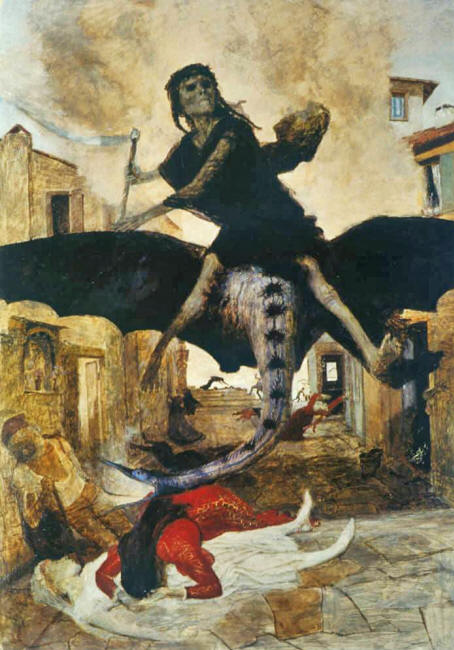|
by Arnold B÷cklin, painted in 1898.
And this one is no
exception. It is a very fine work of analysis of the current state
of the Covid pandemic by way of a classic work of fiction, Albert
Camus'
The Plague.
Referencing Thomas Merton's claim that Camus' fictional account is actually a,
Fendt asserts that perhaps,
This chilling likeness to the asymptomatic Covid-19 victim is but one of the images of what the plague stands for in both the novel and contemporary society.
The existentialist fiction of Camus is unwrapped by Fendt's fidelity to realism and Camus' motivations as an artist.
As Camus calls nihilistic art and culture "barbaric," Fendt calls,
If we are moved by the
forces of powers that be without sense or knowledge of a proper end,
we too have been rendered worse than ignorant.
It is the objective framework within which the society whose myth it is understands their lives; it is what defines and delimits "objective".
The vast majority of mankind does not even think to give what Kant called a transcendental deduction for that framework within in which all their world appears:
One connection between religion and a work of art is just this:
The myth is that in which we are able to know and to feel our existence.
To put things in a more directly philosophical statement,
It is the unconditioned "totality of the conditions for any given condition," the unconditioned ground within which thought and feeling take place and are understood.
It is a mistake to consider what we might call the elements of myth as having,
Without such myths however,
A myth makes of the world a limited complete whole - an opseos kosmos; and this making so can never be a fact in the world, or even a fact about the world.
Its myths are a culture's means of formation - moral, intellectual, emotional, and whatever we might mean by spiritual. As a rule, what lies outside the myth cannot be seen to have happened, cannot be seen to be going on.
The one who tells the myth, supposing there is one:
...has been formed by, as
much as he is forming the story, unless you want to believe in the
myth of the great man inventing his own culture.
This sense of myth does not only apply to those stories, such as Homer's, which we usually intend, but it covers also Nietzsche's sense when,
That he has myths is
symptomatic of a being whose knowledge is limited.
So, we might ask of someone like Sir James Frazer,
Seeing our point, he would confess that it is the myth of empirical science, and undoubtedly chuckle, for everyone here knows that empirical science is not a myth... right?
And Nietzsche's point might not be the insane one of attempting to speak without any grammar whatsoever, but a warning about the wrong way to think about things, into which we are led by, let us call them, the facts of our grammar.
In such a case we would find him aligned with Wittgenstein, who is a much less explosive, but no less insightful writer of German sentences.
In every such case we are
taking the myths as if they refer and have meaning in the same way
that all those things that appear in them (the whole world -
material and social) refer or have meaning, mistaking that through
which and in which we understand to be the same sort of thing as
that which we understand (or wish to understand).
He said that he intended there to be three layers to his work:
The last was to be the center of his reflections in the coming works; thus, after his sudden death, we are left "with an unfinished trilogy".
In the preface to the second edition of his youthful (1937) book of essays, The Wrong Side and the Right Side, published the year after his visit to Stockholm (1958), Camus tells a story of his work which aligns with this layering, for he finds,
He hopes, in the near future,
These statements are the
best sign that Camus is, near the time of this re-printing, taking a
new, at least more clearly defined, aesthetic distance on himself
and his work, framing it as a coherent life-story under the aegis of
these three "stages".
But it also seems quite clear that Camus has been learning from his own work, and one thing he has learned is that, seen truly, love seems to have been,
Or perhaps the center sphere of several, growing like an onion, but written and read - and lived? - from the outside in; perhaps only having lived and written through what is already behind him does he see what the living, growing center has been all along.
In the reading of Camus' own myths it is not evident, within the absurdity of Sisyphus, or within The Rebel, that love is,
Nor the center either...
Indeed, love seems to have a different significance - if it has any, if we treat each of the previous stages as the expression of Camus' myth at the time of its writing.
But perhaps,
Perhaps, then, his late myth about his work is the true confession about his life, as well as his work.
Absurdity, rebellion, love - it's a life trajectory Augustine would recognize, as well as many other sinners.
This latterly told myth of his writing life is the confession of that world within which he wished his work to be understood, within which he understood himself now to have always been working, within which he thought his work could best work - or did, does, and will do its best work - for us.
Those earlier works, taken for themselves - as their own autochthonous myths - were partial, of severely limited focus.
Lucidity about his own life and experience demanded that he be living in another myth, a framework distinct from those - each of which brought its own kind of fame and trouble in its day.
For the sake of understanding this novel as myth of the modern world it is worth recalling Camus' earlier "stages" - those which led into "love."
Let us consider each of them in turn, given Camus' own late told myth, "stories that could be true," of characters who might instantiate them - but rightly seen only if oriented to this proper centering:
|


